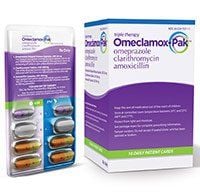This is an automatically translated article.
Amoxicillin is a drug used to treat diseases related to respiratory infections such as pneumonia, acute sinusitis, otitis media, urinary tract infections, skin infections. So how should Acigmentin be used?
1. Uses of the drug Acigmentin
Amoxicillin with the composition of amoxicillin 875mg and clavulanic acid 125mg, is a penicillin combination antibiotic used to treat a variety of bacterial infections such as: otitis media, pneumonia, inflammation acute sinusitis, chronic bronchitis. The drug works by preventing the spread and growth of pathogenic bacteria. This antibiotic only treats bacterial infections. Besides, the drug will not work effectively against viral infections (such as the common cold, flu).
2. Dosage and how to use the drug Acigmentin
2.1. Dosage The dose to be applied will be determined based on factors such as age, weight, and health status of the patient.
For adults and children over 12 years old and over 40kg, the dose will be 625mg/day, 3 times a day. Or if using oral dose of 1000mg / time, it will be used 2 times / day. Children from 2 to 12 years old will use a dose of 30-60 mg/kg, children under 2 years old is 30-40 mg/kg/day, calculated according to amoxycillin. For patients with renal or hepatic impairment, a careful dosage indication is required, the above dosage is not applicable. 2.2. How to use the drug In order for the drug Acigmentin 1000 to maximize its effectiveness, users should take the drug regularly and it is best taken with meals to reduce the risk of stomach pain. In addition, patients should have a reasonable diet, cut down on fatty foods and cholesterol. Patients should exercise regularly to improve their health status as well as increase the body's resistance.
In order for the disease to be in remission, users should follow the correct route of drug use, do not arbitrarily stop taking the drug or increase or decrease the dose until the treatment has been completed, even if the patient feels better. .
3. Acigmentin drug side effects
Some common side effects such as nausea, vomiting, diarrhea, abdominal pain. To minimize this situation, the patient should take the medicine immediately after eating. However, if any of these side effects persist or get worse, tell your doctor right away.
Some serious reactions may occur such as: dark urine, nausea or vomiting for a long time, severe abdominal pain, yellow eyes, jaundice, easy bruising and bleeding, signs of infection such as fever, persistent sore throat, unusual tiredness.
If the patient develops these symptoms, do not use antidiarrheal products or opioids as they can make the symptoms worse.
4. Some important issues to note when using Acigmentin
Before using this medicine tell your doctor if you are allergic to amoxicillin or clavulanic acid or to cephalosporin antibiotics, penicillin...
Before using this medicine tell your doctor or pharmacist your medical history. your medical conditions, especially of: liver disease (including liver problems caused by previous use of amoxicillin or clavulanic acid), kidney disease.
Tell your doctor what medicines you are taking and have recently taken, including prescription drugs, over-the-counter medicines including dietary supplements.
For pregnant or lactating women: Your doctor will usually recommend against using Acigmentin 1000. Although there are no animal studies to date showing any adverse effects of Acigmentin. directly or indirectly on fetal development. However, it is still necessary to be cautious and in the case of really needing to use the drug, it is necessary to carefully consider the benefits and harms that the drug brings.
Above is important information about the drug Acigmentin. Using the right dosage and instructions will help bring good treatment results to patients.
Please dial HOTLINE for more information or register for an appointment HERE. Download MyVinmec app to make appointments faster and to manage your bookings easily.
Reference source: 1mg.com












